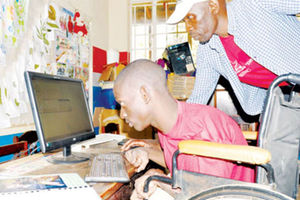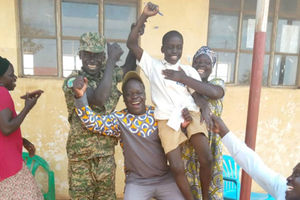
A child with special needs learns computer in Kampala. Many such children lack the materials they need to learn such as embossers, embossing paper, braille machines, braille kits, victor readers, braille papers, among others. PHOTO/FILE
A special Value for Money Audit Report by the Auditor General (AG) John Muwanga shows that only two out of every 100 learners enrolled in primary schools in 2023 are children with disabilities.
The report released in December 2023 reveals that only 17,641 learners in schools visited across 11 local governments with a total population of 897,149 learners, were disabled.
This indicates that the special needs enrolment rate was only 1.97 percent against the expected 16 percent.
“This implies that many learners with special needs have not accessed education services, hindering the country’s progress in providing equitable and affordable access to education services for all by 2030,” reads part of the report.
The report says of the 17,641 enrolled special needs learners, 3,144 have hearing impairments, 2,631 (visually impaired), 3,323 (physically disabled), while another 8,543 have other forms of disabilities.
The findings show that Mbale District had the highest number of special needs learners at more than 3,000, followed by Soroti, Lira, Jinja and Kampala districts, with each recording more than 2,000 learners.
Other districts, including Ngora, Iganga, Kabale, Rukungiri, Isingiro and Masaka had less than 1,000 learners with special needs.
The government yesterday said the findings have since informed its decisions, prompting it to prioritise special needs education.
Mr John Chrysostom Muyingo, the state minister for Higher Education, said the main focus will be placed on special needs students as the government rolls out compulsory primary and secondary education programmes.
“The government aims to see that all children of school-going age are in school but we suffer budget cuts that affect our plans,” he said.
Mr Muwanga indicates in his report that the dropout rates among the special needs children decreased in 2020/2021 and 2022, and significantly increased in 2023.
A total of 331 special needs pupils were in Primary One to Primary Four in 2019. The number of those in P2 to P5 increased to 401, while those in P3 to P6 decreased to 385 learners in 2022 before those between P4 and P7 dropped to a lowly 227 in the year under review.
“The substantial 21 percent increase in the number of learners with special needs observed in 2020/2021 can be attributed to the disruptions caused by the Covid-19 pandemic.
Officially, there was progression between classes, but some learners moved classes. This surge was followed by a gradual decline in the subsequent years as students advanced to higher classes,” reads the report.
“Furthermore, the audit team observed, through interviews and examination of reports submitted by the Education ministry and education officers responsible for special needs in the selected districts that there was no system in place to monitor or track the dropout or progression rates of learners with special needs in the country,” it adds.
But education stakeholders yesterday attributed the low enrolment rate and increased dropouts for special needs learners to poor learning conditions, poverty and funding gaps, which cripple proper service delivery to the students.
Mr Hasadu Kirabira, the chairperson of the National Private Education Institutions Association (NPEIA), said they couldn’t solve the problem all by themselves unless the ministry supplements.
“We proposed an intervention that causes mandatory fixing of infrastructure for students living with disabilities. This is through the Ministry of Works and the Building Review Board. We need to put in place the infrastructure that caters for learners with disabilities as a requirement for schools that seek liberation, like alternative walkways, toilets, and wraps where learners with disabilities pass as we believe this will keep many of them in schools,” he said.
“Most of our teachers are unable to handle learners with disabilities so we have also called on the Ministry of Education to ensure all the teachers’ colleges and universities involve an aspect of learners with disability management to ensure balance,” he added.
Ms Esther Kyozira, the chief executive officer of the National Union for Persons with Disabilities (NUDIPU), said they are mobilising communities, creating awareness for parents and building capacity of the teachers through their programme for inclusive education.
“We are training them on how to handle children with disabilities in class and make sure this child is comfortable when at school and is not teased by their fellow learners. We are holding meetings with the government, including the Ministry of Education, and presenting them the challenges parents face, including financial problems,” she said.
Learning materials
The Education ministry is mandated, through its Special Needs and Inclusive Education (SNIE) Department, to provide adequate special instructional materials and equipment, upgrade equipment and materials to meet the prevailing standards of teaching and learning for learners with special needs.
Mr Muwanga stated in the report that the SNIE Department bought and distributed instruction material and assistive devices worth Shs2.2b to various special/unit/inclusive schools in the country between 2019/2020 and 2022/2023.
These included embossers, embossing paper, braille machines, braille kits, victor readers, braille papers, drawing slates, wheelchairs, white canes, screen readers, television, radios, talking calculators, Taylor math frames, braille maths teaching, laptops, magnifying glasses, and sign language dictionaries.
Mr Muwanga said the quantity of materials bought were insufficient to meet the needs of all learners with special needs in the country, “considering that there were 2,631 registered learners with visual impairments and 3,144 with hearing impairments in the 11 sampled local governments alone.”
The report indicates that some schools received materials that were not modified to accommodate the needs of certain categories of students, citing the desktop keypads which were not modified for the visually impaired learners and chairs not modified for learners with cerebral palsy.
Poor PLE performance
According to the 2023 Primary Leaving Examinations (PLE) results that were released on January 25, less than five percent or 121 out of 2,606 special needs candidates passed with First Grade.
Results from Uganda National Examination Board (Uneb) indicate that the majority of special needs pupils passed in Division Two, Three and Four.
Prof Celestino Obua, the Uneb Board chairperson, attributed the failure rate to lack of equipment needed by the SNE learners.
Education minister Janet Museveni also pledged government support towards SNE.
“We shall study further this area of assessment and examination of SNE learners and see what feasible interventions we need to make in a manageable manner without compromising the quality of education these categories of learners access and attain,” she said.
Subvention grants
The Education ministry is obligated under its policy guidelines on universal education to provide subvention grants to support schools enrolling a minimum of seven learners with special needs at a rate of Shs1.2m per learner per annum to cater for food, medical care and instructional supplies.
Mr Muwanga said in the report that a review of grant allocations to schools revealed that the ministry was mainly giving SNE subvention grants to unit and special needs schools, encompassing 125 schools across the country.
The audit also found that the grant allocations for all the years reviewed were much lower than the Shs1.2m specified in the guide.
“In addition, only five schools with a total enrolment of 628 learners, out of 343 schools with a total enrolment of 12,793 learners, inclusive schools that met the minimum threshold of seven learners in the 11 local governments visited, received the SNE subvention grant, and this left 338 inclusive of schools that met the minimum enrolment requirement and with a total enrolment of 12,165 learners with special needs with no grant support from government,” the report says.
Ms Kyozira wondered why the government continues to underfund this area, which handles very delicate learners.
“All the years we have been complaining about the challenge of the small allocation that goes to the special needs department, and yet they are dealing with a very complicated constituency where the children with disabilities don’t have one need, but each disability has a specific need and requires specific intervention,” she said.
SNE
School enrolment
There are 172,864 children with special needs in primary schools, which is two percent of total primary level enrolment and nine percent of the overall children with special needs, with hearing impairment constituting 27.2 percent, mental (22.7 percent), visual (25.8 percent), and physical impairments (17.9 percent).
Source: Factsheet, World bank Group, February 7, 2020
Special needs
The numbers
Considering that 5.82 percent of Ugandan children are estimated to be with disabilities, this translates to 2,027,148 children with disabilities (1,052,000 boys and 974,488 girls), (National Action Plan for Children with Disabilities 2016/2017- 2020/2021.
Source: Ministry of Gender, Labour and Social Development.
Additional reporting by David Walugembe




